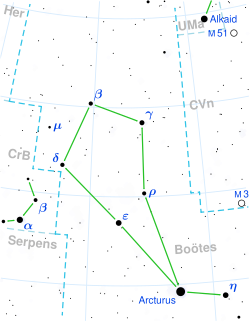Asellus Secundus
| Asellus Secundus (ι) | |
 | |
| Observationsdata Epok: J2000.0 | |
|---|---|
| Stjärnbild | Björnvaktaren |
| Rektascension | 14t 16m 09,92995s[1] |
| Deklination | 51° 22′ 02,0267″[1] |
| Skenbar magnitud () | 4,75[2](4,73 till 4,78 [3]) |
| Stjärntyp | |
| Spektraltyp | A7 V[4] |
| U–B | 0,06 [5] |
| B–V | 0,20[5] |
| Variabeltyp | Delta Scuti-variabel[3] |
| Astrometri | |
| Radialhastighet () | -18,7 [6] km/s |
| Egenrörelse (µ) | RA: 88,72[1] mas/år Dek.: -399,07[1] mas/år |
| Parallax () | 34,40 ± 0,19[1] mas |
| Avstånd | 94,8 ± 0,5 lå (29,1 ± 0,2 pc) |
| Absolut magnitud () | 2,38[7] |
| Detaljer | |
| Massa | 1,81[4] M☉ |
| Radie | 1,6[7] R☉ |
| Luminositet | 9,6[7] L☉ |
| Temperatur | 8 000[7] K |
| Metallicitet | 0,19[8] |
| Vinkelhastighet | 144[9] |
| Andra beteckningar | |
| 21 Bootis, BD + 52 ° 1784, FK5 528, HD 125161, HIP 69713, HR 5350, SAO 29071, Wo 9474, WDS J14162 + 5122 | |
Asellus Secundus eller Jota Bootis (ι Boo, ι Bootis), som är stjärnans Bayerbeteckning, är en dubbelstjärna i stjärnbilden Björnvaktaren, och som befinner sig på ett avstånd av ca 95 ljusår från solen. Den har en följeslagare på ett vinkelavstånd av 38,6 bågsekunder, lätt separerad med kikare från huvudstjärnan.
Nomenklatur
Stjärnan har det traditionella namnet Asellus Secundus (latin för "andra åsnefölet") och Flamsteedbeteckning 21 Bootis. Den utgör, tillsammans med de andra Aselli (θ Boo, κ Bu och λ Boo), Aulād al Dhi'bah ( أولاد الضباع - aulād al Dhi'b), som kan översättas till "hyenans valpar".[10]
Komponenter
Den primära komponenten, Asellus Secundus, är en vit dvärg i huvudserien av spektraltyp A med en genomsnittlig skenbar magnitud på 4,75. Den klassificeras som en variabel stjärna av Delta Scuti-typ och dess ljusstyrka varierar inom magnitud 4,73-4,78 med en stabil period på 38 minuter. [7]
Följeslagaren HD 234121 är en stjärna i huvudserien med magnitud 8,27, tillhörande spektralklass K0.[11] Den är separerad från huvudstjärnan med 1 100 AE.[4]
Washington Double Star Catalog listar som en tredje komponent en stjärna av 14:e magnituden med en separation på 90 bågsekunder.[11]
Källor
- Den här artikeln är helt eller delvis baserad på material från engelskspråkiga Wikipedia, tidigare version.
Referenser
- ^ [a b c d e] van Leeuwen, F. (November 2007), "Validation of the new Hipparcos reduction", Astronomy and Astrophysics, 474 (2): 653–664, arXiv:0708.1752Freely accessible, Bibcode:2007A&A...474..653V, doi:10.1051/0004-6361:20078357
- ^ Malagnini, M. L.; Morossi, C. (November 1990), "Accurate absolute luminosities, effective temperatures, radii, masses and surface gravities for a selected sample of field stars", Astronomy and Astrophysics Supplement Series, 85 (3): 1015–1019, Bibcode:1990A&AS...85.1015M
- ^ [a b] Samus, N. N.; Durlevich, O. V.; et al. (2009). "VizieR Online Data Catalog: General Catalogue of Variable Stars (Samus+ 2007-2013)". VizieR On-line Data Catalog: B/gcvs. Originally published in: 2009yCat....102025S. 1. Bibcode:2009yCat....102025S.
- ^ [a b c] De Rosa, R. J.; Patience, J.; Wilson, P. A.; Schneider, A.; Wiktorowicz, S. J.; Vigan, A.; Marois, C.; Song, I.; MacIntosh, B.; Graham, J. R.; Doyon, R.; Bessell, M. S.; Thomas, S.; Lai, O. (2014). "The VAST Survey - III. The multiplicity of A-type stars within 75 pc". Monthly Notices of the Royal Astronomical Society. 437 (2): 1216. arXiv:1311.7141Freely accessible. Bibcode:2014MNRAS.437.1216D. doi:10.1093/mnras/stt1932.
- ^ [a b] Ducati, J. R. (2002). "VizieR Online Data Catalog: Catalogue of Stellar Photometry in Johnson's 11-color system". CDS/ADC Collection of Electronic Catalogues. 2237. Bibcode:2002yCat.2237....0D.
- ^ Evans, D. S. (1967). "The Revision of the General Catalogue of Radial Velocities". Determination of Radial Velocities and their Applications. 30: 57. Bibcode:1967IAUS...30...57E.
- ^ [a b c d e] Kiss, L. L.; Alfaro, E. J.; Bakos, G.; Csak, B.; Szatmary, K. (1999). "On the monoperiodicity of the suspected delta Scuti star Iota Bootis". Information Bulletin on Variable Stars. 4698: 1. Bibcode:1999IBVS.4698....1K.
- ^ Gray, R. O.; Graham, P. W.; Hoyt, S. R. (2001). "The Physical Basis of Luminosity Classification in the Late A-, F-, and Early G-Type Stars. II. Basic Parameters of Program Stars and the Role of Microturbulence". The Astronomical Journal. 121 (4): 2159. Bibcode:2001AJ....121.2159G. doi:10.1086/319957.
- ^ Zorec, J.; Royer, F. (2012). "Rotational velocities of A-type stars. IV. Evolution of rotational velocities". Astronomy & Astrophysics. 537: A120. arXiv:1201.2052Freely accessible. Bibcode:2012A&A...537A.120Z. doi:10.1051/0004-6361/201117691.
- ^ Allen, R. H. (1963), Star Names: Their Lore and Meaning (Reprint ed.), New York: Dover Publications Inc, p. 105, ISBN 0-486-21079-0, hämtad 2010-12-12
- ^ [a b] Mason, Brian D.; Wycoff, Gary L.; Hartkopf, William I.; Douglass, Geoffrey G.; Worley, Charles E. (2001). "The 2001 US Naval Observatory Double Star CD-ROM. I. The Washington Double Star Catalog". The Astronomical Journal. 122 (6): 3466. Bibcode:2001AJ....122.3466M. doi:10.1086/323920.
Externa länkar
Media som används på denna webbplats
Författare/Upphovsman:
- Bootes_constellation_map.png: Torsten Bronger
- derivative work: Kxx (talk)
Boötes constellation map showing the stars: Tau Boötis, Eta Boötis, Iota Boötis, Lambda Boötis, 12 Boötis, Nu Boötis, HD 123657


